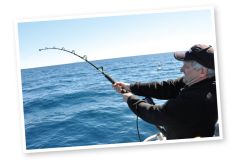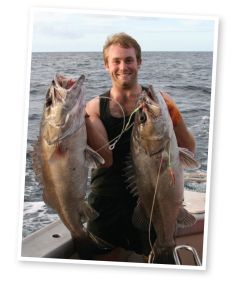Fishing Deep
Deepwater fishing for large, tasty fish like hapuku, bass, gemfish and bluenose is not everyone’s cup of tea, but get it right and it can be very rewarding – on the day and later at the dinner table.
 Our most popular deepwater fish live near structure: reefs, rises, marine shelves and drop-offs. Finding deepwater structure will put your boat near fish, while a good sounder and someone who knows how to interpret it will do the rest.
Our most popular deepwater fish live near structure: reefs, rises, marine shelves and drop-offs. Finding deepwater structure will put your boat near fish, while a good sounder and someone who knows how to interpret it will do the rest.
Most deepwater fishing is done from a drifting boat, so judging the direction and speed of the drift is vital. The skipper needs to give anglers time to get their gear to the bottom before the boat has passed over the fish, which takes considerable skill.
Gearing up for bottom dwellers
 Your basic deepwater set should be durable, robust and suitable for 24 or 37kg line. Reels need to be strongly built and able to hold at least 500m of line.
Your basic deepwater set should be durable, robust and suitable for 24 or 37kg line. Reels need to be strongly built and able to hold at least 500m of line.
Superbraid (gel-spun polyethylene or GSP) lines mean it’s no longer necessary to use large 6/0 and 9/0 ‘game’ reels, but such reels do offer rugged construction that smaller, lighter reels may lack. You can always top-shot your 6/0 reel with 500m of GSP line.
If you opt for smaller reels, be sure they have the internal strength to handle big fish wound to the surface from deep water. You’ll also need a reliable drag system powerful enough to fish the chosen line weight and two-speed retrieves are desirable. These days there are plenty of suitable smaller reels built to fish superbraid, with the capacity and strength for deepwater fishing. Most are not cheap, however.
Matching rods should also be good quality. Most people use medium-quality stand-up game rods – anything from 15kg to 37kg rated – but modern mechanical jigging rods are a good option, and there are also specialist rods for ‘dendoh’ fishing with electric reels. Electric reels holding 800m or more of heavy superbraid line are the ultimate deepwater fishing tools, although they also have applications in lighter-tackle fishing in shallower water.
Many anglers choose a rod one line-class lighter than the line they’re fishing – a 24kg rod with 37kg braid, for instance. The extra flex of a lighter rod offers some insurance against break-offs and ripping hooks out.
Simple rigs
 Two-hook dropper rigs are the most popular deepwater rig. In such deep water, visibility is not really an issue so heavy trace is used, providing insurance against teeth and sharp gill plates. The most usual is 100kg mono and 200kg is common enough.
Two-hook dropper rigs are the most popular deepwater rig. In such deep water, visibility is not really an issue so heavy trace is used, providing insurance against teeth and sharp gill plates. The most usual is 100kg mono and 200kg is common enough.
Pre-made ‘hapuku traces’ are available at most tackle shops. They’re convenient, but not all are well made. Rigs are easy enough to tie yourself, though this is best done before a fishing trip, not in the middle of a hot bite.
Dropper loops should be short and far enough apart not to tangle with one another. The whole rig should be about two metres long, with the bottom hook 0.75m and the top hook 1.5m from the sinker. A strong swivel at the top completes the rig.
You can thread your dropper loops through a short length of luminescent plastic tube or add lumo beads, plastic squids etc. before attaching the hook. Most commercially made rigs are made this way. The tube glows in the dark and also acts like a semi-rigid boom, preventing the hooks from tangling around the trace backbone.
Some anglers like to tie Cyalume light sticks to their rig. They are a definite advantage when the fishing is hard and probably essential when fishing after dark. Light sticks work best in really deep water – 400m-plus – with smaller ones better than large ones. Some come ready to clip on your trace, others need to be tied or taped. Poor quality light sticks burst at these depths, so beware.
Hooks
 Circle hooks are the way to go – simply wind into the weight of the fish when you feel a solid bite. Many people use 16/0 hooks for deepwater fishing. That’s fine if all the fish on your drift are trophy-sized, but usually they’re not. I prefer 14/0 circle hooks, or even 10/0 and 12/0 sizes. You’ll still hook the big boys, but stand a better chance of catching their normal-sized mates. Some anglers deliberately fish one large hook and one much smaller hook, or add a third small hook tied to the swivel on a lighter trace to target smaller fish like tarakihi.
Circle hooks are the way to go – simply wind into the weight of the fish when you feel a solid bite. Many people use 16/0 hooks for deepwater fishing. That’s fine if all the fish on your drift are trophy-sized, but usually they’re not. I prefer 14/0 circle hooks, or even 10/0 and 12/0 sizes. You’ll still hook the big boys, but stand a better chance of catching their normal-sized mates. Some anglers deliberately fish one large hook and one much smaller hook, or add a third small hook tied to the swivel on a lighter trace to target smaller fish like tarakihi.
Superbraid lines allow the angler to feel bites in very deep water so standard J-hooks are also an option.
Sinkers
 A good sinker should deliver your baits to the bottom fast and offer as little resistance as possible during the long wind back up.
A good sinker should deliver your baits to the bottom fast and offer as little resistance as possible during the long wind back up.
Beware of sinkers with flat sides, as these may plane and flutter on the way down or spin on the way up.
Depending on depth and current, you should have at least 16 ounces (450g) and up to 40 ounces (1.1kg) of weight. Sacrificial traces or ‘break-aways’ between sinker and dropper rig are not a bad idea, saving lost fish, but you will lose sinkers you might otherwise pull free.
 Best baits
Best baits
In general fresh bait is best; however, frozen barracouta is excellent ‘puka bait. Skipjack is excellent if caught on the way to the grounds but too soft if frozen. Squid is good but it must be in good condition. Squid that appears pinky-purple, or seems very washed out and pale, is just about useless.
Fresh-caught mackerel is excellent bait. Catch it and ice it down with care – the better its condition, the better it will fish. Flying fish is good when fresh and livebaits will catch hapuku, bass and big kingfish. Just hook livies through the nose and send them down.
Use streamlined cut baits that are not too big. Oversize baits take longer to get to the bottom and may plane the whole rig up out of the strike zone as the boat drifts. They are also harder to retrieve.
Change baits regularly, preferably after every drift. Scent, oils and juices are quickly squeezed out of cut baits by many atmospheres of water pressure.
Get down!
 The keys to success in deepwater drift-fishing are getting your baits to the bottom as quickly as possible – and keeping them there.
The keys to success in deepwater drift-fishing are getting your baits to the bottom as quickly as possible – and keeping them there.
In good conditions, staying in the strike zone is not usually a problem. But wind and tide can conspire to make it all but impossible to stay in contact with the bottom. Sometimes you’ll have to let out 400 metres of line just to get to the bottom in 200 metres of water, especially if using monofilament line. Water drag forms a belly in the line, which can lift sinker and baits off the bottom and away from the fish.
Superbraid lines are fine in diameter and have no stretch, so there’s less water drag and much better feel. You’ll know when your sinker touches the bottom and when fish are biting.
The sinker should drag across the bottom but not lift off it for any length of time. The angler needs to continuously drop back to the seabed by releasing more line. It can be tricky: wait too long between drop-backs and baits will lift too far off the bottom; let out too much line and risk putting a huge belly in the line and possibly snagging up on the bottom.
The bite
 It is very obvious when you hook a fish using superbraid lines. You’ll generally feel knocks and bites with most fish hooking themselves. Wind into a bite or let the rod load up. A bent rod means ‘fish on’.
It is very obvious when you hook a fish using superbraid lines. You’ll generally feel knocks and bites with most fish hooking themselves. Wind into a bite or let the rod load up. A bent rod means ‘fish on’.
Using mono, it’s much harder to detect a bite. Sometimes it’s simply a sensation of extra weight. If you think you may have a fish, crank the reel’s handle until the line comes tight, then lift the rod high and hold it there. If the rod stays bent, you have a fish; if the tip gradually straightens, you have a sinker and two baits.
Really big bass or hapuku can feel like a snag. Be patient. If you can gain line you have a fish, but if you’re steadily losing line as the boat drifts away, you’ve caught the bottom.
With superbraid lines, you can almost always feel the difference between a fish and a snag since the line faithfully transmits every headshake and tail beat to the rod.
Go hard early
Once you’ve hooked a fish, you need to put the pressure on. You want to pull the fish clear of the bottom – big hapuku, bass and bluenose will do their best to drag your gear into the rocks to free themselves. Hapuku and bass hooked on superbraid line pull like trains and big fish will strip off plenty of line against hard-set drags.
Once clear of the bottom, you can pace yourself and maintain steady pressure. When hapuku and bass are close they will often float to the surface as their air bladders inflate. Bluenose vent themselves. Blown fish cannot be returned to the water.
Care for your catch
Ice your fish immediately. One hour in the sun is equal to one day in the fridge; three hours without ice and your fish will be just about stuffed. Big fish need a lot more ice than small ones, so don’t stint on ice. Salt ice is better than fresh water ice because it’s colder.
Fish tastes a whole lot better if you look after it.
Limit your catch
The daily recreational bag limit for hapuku and bass is five (5), combined with kingfish, of which no more than three (3) may be kingfish.
All other deepwater fish (like bluenose, gemfish, frostfish, ruby fish etc.) come under the 20-finfish limit. That means you are allowed twenty (20) bluenose, which may average 15kg each. That’s an astounding 300 kilograms of bluenose per person per day! Nobody needs that much fish, so set your own limits based on what you need for a good feed. Aim to limit your catch, not catch your limit.
Species:Gemfish Hapuku, Bass and Bluenose Kingfish Squid Tarakihi
